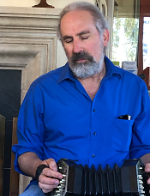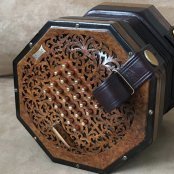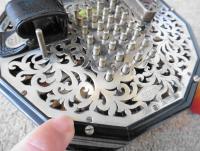
Patrick McMahon
Members-
Posts
271 -
Joined
-
Last visited
Profile Information
-
Gender
Male
-
Interests
Music and instrument renovation
-
Location
UK
Recent Profile Visitors
1,129 profile views
Patrick McMahon's Achievements

Chatty concertinist (4/6)
-
Any Ideas For The Short-Of-Thumb?
Patrick McMahon replied to Stonie's topic in General Concertina Discussion
i did search, but nothing came up. That actually doesn't sound like a bad set-up. I often find that when I need to suck in air, I end up doing the opposite. If you had that kind of one-way valve, you could just operate the left to gain air, and the right to vent some. More work for a manufacturer, but a nice simple principle for a player. Probably more attractive to non-expert players like me. You wouldn't think a good player would have any problem controlling the air on a good concertina. -
Any Ideas For The Short-Of-Thumb?
Patrick McMahon replied to Stonie's topic in General Concertina Discussion
Just saw this Edeophone on ebay with what looks like a factory-made air lever. It seems to be operated by the left-hand thumb, pushing outwards. Not what you would first think of for a natural action, but it might work better than first impressions. Seems well made, and has obviously lasted getting on for a century in good condition. -
A Baffling Anglo - Confused Of Cheshire
Patrick McMahon replied to nkgibbs's topic in Concertina History
I agree it looks very like a Lachenal, apart from the ends. And a serial number of 1958 would indicate someone who made a lot of concertinas. The only thing against the Lachenal with replacement ends idea, is the palm rests. Why would you make new ones, rather than re-use the Lachenal ones? In which case they would have had the trade mark. Or would a Lachenal with the 1958 serial actually have the Lachenal reed trade mark on the rests? -
Oh, so innocent. Many people have said that they were only going to buy one. Not many stick to it. I look on it as a free hobby. As someone said above, you can buy a concertina, own it for years, and sell it for more than you paid for it, if you buy wisely. I've never lost money on one, but then I can do maintenance. It's not rocket science. Obviously, if you buy from a shop, you'll probably struggle to sell it for what you paid for it, but that's the price for the service. However you go about it, it's not an expensive hobby, unless you go mad buying. C/G or D/G would be ok. D/G probably edges it for what you described, but C/Gs are a lot more available, there are far more to choose from secondhand.
-
As it says on the box Heidi, it's German. Quite old, I'm guessing 1920s but that could be wildly out. They were made in huge numbers in this configuration, and it's not a valuable or sought after model, so I wouldn't spend cash on it unless it's for sentimental reasons. It doesn't look in bad condition for it's age though, so it might play ok, if anyone fancies learning the art.
-
One thing I've observed, which others may or may not agree with, is that it's harder to switch from the English system to Anglo, than vice versa. I started with a harmonica, so the Anglo arrangement of different notes on blow and suck were familiar. But I've often seen Anglos for sale by people who play the English, and thought that they'd give an Anglo a try, but couldn't get their heads around the different notes on push and pull, having learn't the English. I've never seen the reverse, so maybe, if it really comes to a toss-up, it would be better to plump for the Anglo, as it might be easier to change later.
-
With a good old English name like biscuitbox, i'm guessing that Tarquin is in the UK. If so, then what you REALLY need to know is the difference between the ENGLISH and the ANGLO. ( With all respect to duet players). It's purely down to the layout of the buttons and the corresponding reeds, as stated above. Anglo is a different note on the push and pull, English is the same note push and pull. Most UK people will just use the name Anglo for all 20 and 30 button concertinas, even if they are actually German. Historically, English players were a bit more into classical or performance music and Anglo players more into folk music played at home. But it's very blurred now. I would get to listen to both styles, and pick the one that you would like to emulate.
-
Midland Concertina Group 8Th April 2017
Patrick McMahon replied to Mikefule's topic in General Concertina Discussion
Nobody ever thinks about the absolute beginners, with 30+ years of experience. -
If I was in your shoes, I would give up on the idea of ordering direct from the manufacturer. Normally, they will just refer you to an agent in your country, and they are unlikely to want to dabble in just the odd reed. (I'm guessing, other's might disagree). I would look to buy an old scrap accordion or melodeon and use reeds from it. If they are really rough, you can get them for peanuts. A piano accordion will have reeds that are the same note, for push and pull. But you can do a bit of re-tuning, one down a bit and the other up a bit, to get the notes combinations that you want. If you want to learn from the project, that might be just the thing to learn tuning techniques.
-
What Defines A 'quality' Concertina?
Patrick McMahon replied to Teriodin's topic in General Concertina Discussion
If anyone out there wants to pay far too much money for an old-looking, battered, damaged, distressed concertina, feel free to pm me. -
What Defines A 'quality' Concertina?
Patrick McMahon replied to Teriodin's topic in General Concertina Discussion
The comment about "ageing" a violin rings very true. It's fashion, that's all. Nobody is immune to it, and if it makes you feel good, why not? Certain things just look better with a bit of ageing, even if it's fake. Go into Tesco's, and look at the denim jeans section. You will see brand new jeans with the knees deliberately ripped and frayed, and they are faded and stone-washed to make them look old. They start at twenty pounds. Go next door to the charity shop, and you can buy genuinely worn and faded ones for 99p. It's a crazy world out there. -
I can't believe that the one I linked sold for £142 plus postage. Are smaller concertinas worth such a premium? I've seen full size ones similar to that one sell for about thirty pounds.
-
What Defines A 'quality' Concertina?
Patrick McMahon replied to Teriodin's topic in General Concertina Discussion
I'd still rather have leather. I love the smell of it, and leather combined with real wood has "life" that other materials don't have. Not logical, but it's still there. -
What Defines A 'quality' Concertina?
Patrick McMahon replied to Teriodin's topic in General Concertina Discussion
Experience and knowledge of the concertina "market" come into it. There might be no way of knowing, just from handling a brand new cheaper concertina, that it will not last and become wheezy and rickety over time. People get to know that sort of thing by handling older ones, and talking to others who have owned them. So personal experience, and word of mouth, play a big part in defining what's a good quality concertina. There's plenty of that on this site.




